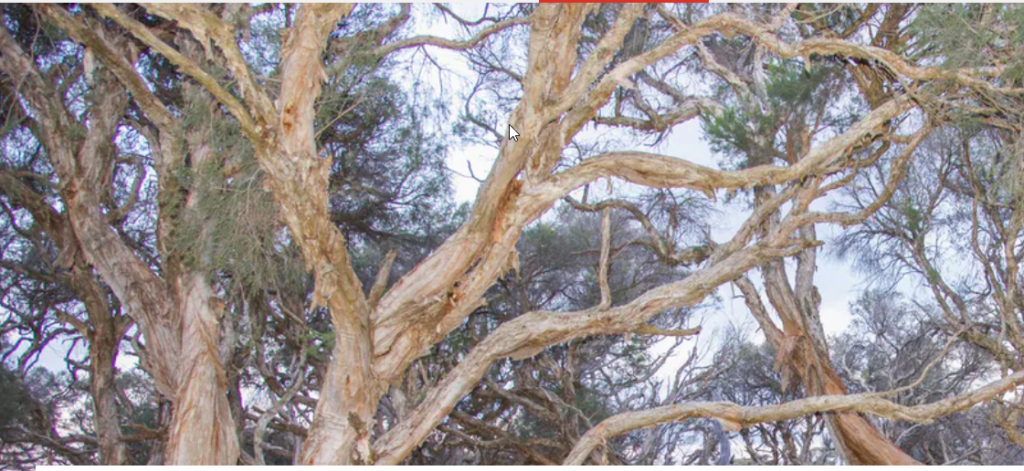
Trees are Earth’s lungs. We know, for a fact, that they draw down and lock up vast amounts of carbon dioxide from the atmosphere. Emerging research is showing that trees can also emit methane. However, we don’t know exactly how much yet.
Unfortunately, for the environment, this could be a big problem. Methane is a greenhouse gas. It’s about 45 times more potent for warming the environment than carbon is. Wow! Yeah. Read that again. Methane is a greenhouse gas that is 45 times more potent for warming the environment than carbon is.
Mind-boggling, right?
Even though all the data is not in yet, researchers have found a potential solution in the form of a unique methane-eating communities of bacteria living within the bark of a common Australian tree species known as paperbark (Melaleuca quinquenervia). These microbial communities are abundant, thriving and mitigated about one third of the substantial methane emissions from paperbark that would’ve otherwise ended up in the atmosphere.
Research on tree methane, aka treethane, is still in its relative infancy. As a result, there are many questions that need to be resolved. This discovery helps fill in the critical gaps and changes our understanding of the way we view the role of trees in the global methane cycle.
We know it’s still mind-boggling that trees emit methane. However, this is not new information. We have known about it since the beginning of the 20th century. Methane gas was first reported in cottonwood trees back in 1907. In 2018, there was a tree methane review which labeled this fact as a “new frontier of the global carbon cycle.” The research has spread to forests in Japan, UK, Germany, Finland, Panama, China and more locations around the globe.
In some cases, treethane emissions are significant. Did you know the tropical Amazon basin is the world’s largest natural source of methane. Trees there account for 50% of its methane emissions. Similar research from 2020 found low-lying Melaleuca forests in Australia that emit treethane at rates close to those found in the Amazon.
Even more interesting is the fact that dead trees can emit methane too. At the site of a catastrophic climate-related mangrove forest dieback in the Gulf of Carpentaria, dead mangrove trees were emitting eight times more methane than living ones. This poses new questions for how climate change may induce positive feedbacks, triggering potent greenhouse gas release from dead and dying trees.
Therefore, treethane emissions most likely account for some of the large uncertainties within the most recent global methane budget. This tries to determine where all the methane in the atmosphere comes from. Of course, we’re still a long away from refining an answer to this question. Currently, trees are not included as a distinct emissions category.
This begs the question – where exactly is the treethane coming from?
Scientists assumed that most treethane emissions originate from the underlying soils in wetland forests. The methane is then transported upwards via the tree roots and stems, then through to the atmosphere via their bark. Research has also confirmed that wetland soils were indeed the source of methane emissions in lowland forest trees. This, however, was not always the case.
Some lowland forest trees like cottonwood emit flammable methane directly from their stems. It is likely produced by microbes living within the moist trees themselves. Dry upland forest trees are also emerging as methane emitters too at much lower rates.
Researchers discovered the methane-eating bacteria using microbial extraction techniques. They discovered the bark of paperbark trees provide a unique home for methane-oxidizing bacteria – bacteria that ‘consumes’ methane and turns it into carbon dioxide, a far less potent greenhouse gas. These bacteria make up about 25% of total microbial communities living in the bark and consumed up to 36% of the treethane. The microbes make an easy living in the dark, moist and methane-rich environments.
The discovery revolutionizes the way in which we view methane-emitting trees and the novel microbes living within them. By understanding the why, how, which, when and where trees emit the most methane, we can more effectively plant forests that effectively draw down carbon dioxide while avoiding unwanted methane emissions. The discovery that bark-dwelling microbes can mitigate substantial treethane emissions complicates this equation but provides some reassurance that microbiomes have evolved within trees to consume methane as well. Future work will undoubtedly look further afield exploring the microbial communities of other methane-emitting forests.
Let’s be clear – trees are in no way shape or form bad for our climate and provide a swath of other priceless ecosystem benefits. The amount of methane emitted from trees is generally dwarfed by the amount of carbon dioxide they will take in over their lifetime.
There are currently 3.04 trillion trees on Earth. With both upland and lowland forests capable of emitting methane, mere trace amounts of methane on a global scale may amount to a substantial methane source. As we now have a global movement aiming to reforest large swaths of the Earth with 1 trillion trees, knowledge surrounding methane emitting trees is critical.
We hope you enjoyed this article as much as we enjoy bringing it to you. Please stay tuned for more tree news.











